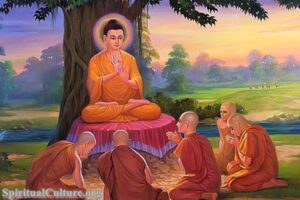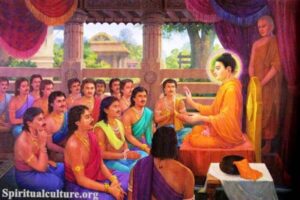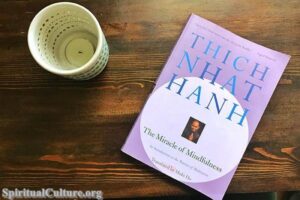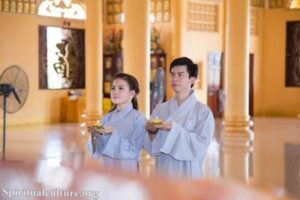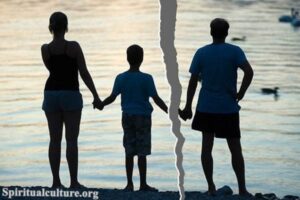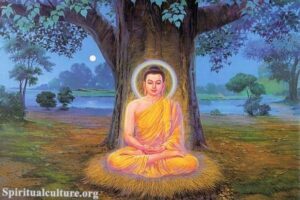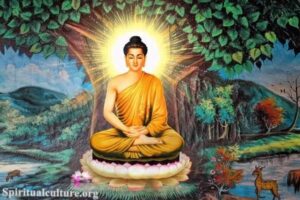Freedom — we all yearn for it. But what kind of freedom are we truly seeking? Is it the liberty to choose whatever we want, or is it the peace of no longer needing to choose at all? Is it the absence of control, or the presence of wisdom? For many, the word freedom conjures political or personal liberties. Yet, for the Buddhist path, freedom is an inner reality, discovered not by acquisition, but by letting go.
As Spiritual Culture, we invite you to explore the Buddhist understanding of freedom — not as a fleeting feeling, but as a liberating truth. In this journey, we will uncover how freedom is defined in the Dhamma, why it matters more than ever, and how you can touch the edge of this awakening in your own life. True freedom, in the Buddhist view, is not outside of you — it is who you are when the illusions fall away.
The Nature of Bondage in Buddhist Thought
Before we can speak of freedom, we must understand what binds us.
Samsara: The Cycle That Enslaves
In Buddhism, the core human problem is not sin or error, but samsara — the endless cycle of birth, death, and rebirth. This cycle continues due to craving (taṇhā), ignorance (avijjā), and attachment (upādāna). We are bound not by external chains, but by mental and emotional patterns that keep us reacting, clinging, and fearing.
“It is craving which leads to renewed existence… accompanied by delight and lust, seeking delight here and there.”
— Samyutta Nikaya 56.11 (The First Noble Truth)
Samsara is not a place. It is a state of mind — a restless wandering in search of something lasting, something satisfying. But the more we grasp, the more we suffer. To be bound by samsara is to be trapped by our own illusions, not realizing we are grasping at shadows.
The Illusion of Self
Another key bondage is the belief in a fixed, permanent self — atta. The Buddha taught that what we take to be “me” or “mine” is just a collection of changing processes: body, feeling, perception, mental formations, and consciousness. These are called the five aggregates (pañcakkhandha).
To cling to the idea of a self is to suffer, because that “self” is always changing, aging, and slipping through our fingers.
“All conditioned things are impermanent — when one sees this with wisdom, one turns away from suffering.”
— Dhammapada 277
True bondage is to believe that what is impermanent can satisfy us. We are not free because we seek freedom in the wrong place.
What Is True Freedom According to Buddhism?
True freedom (vimutti) is the release from the forces that bind consciousness: craving, aversion, and delusion. It is not a freedom to do anything, but a freedom from the things that once ruled us.
Freedom from Craving
The first and most central form of freedom in Buddhism is liberation from taṇhā — craving or thirst. Whether it’s sensual desire, the desire to become something, or the desire to not become something — all of it creates suffering.
When one is free from craving, the heart no longer chases after pleasure or flees from pain. It rests.
Freedom from Ignorance
The Buddha often spoke of ignorance (avijjā) as the root of bondage. To be ignorant is not just to lack knowledge, but to misperceive reality. It is to see permanence in the impermanent, joy in the painful, and self in the not-self.
Freedom comes through paññā, or wisdom — the direct seeing into the nature of things.
“Just as the ocean has one taste — the taste of salt — so too does my teaching have one taste: the taste of freedom.”
— The Udana 5.5
Freedom from Identity and Possession
Buddhism teaches that freedom means letting go of the need to define, possess, or control. It is an emptying out, not a filling up. The person who is free no longer says “This is me” or “This is mine.”
Even the idea of “being free” is eventually released. One simply is — open, compassionate, awake.
How Freedom Is Practiced in the Buddhist Path
True freedom is not attained through belief, but through transformation.
The Noble Eightfold Path
The Eightfold Path is the Buddha’s map to freedom. It is not a list of commandments but a way of living that gradually loosens the knots of suffering.
- Right View — seeing things as they are
- Right Intention — renouncing harmful motives
- Right Speech, Action, Livelihood — ethical conduct
- Right Effort, Mindfulness, Concentration — mental discipline
Each step is a form of inner freedom. When we refrain from lying, we free ourselves from fear. When we practice mindfulness, we free ourselves from compulsive thinking.
“By oneself is evil done, by oneself is one defiled… purification depends on oneself.”
— Dhammapada 165
No one can grant us freedom. We must walk the path ourselves.
The Practice of Letting Go
Renunciation (nekkhamma) in Buddhism is not rejection of the world, but the deep letting go of that which causes suffering. Even monks, who give up family, status, and wealth, do so not out of rejection — but liberation.
But letting go doesn’t require becoming a monk. Every moment of mindful non-attachment is a step toward freedom.
Mindfulness: The Gate to Inner Liberation
Satipaṭṭhāna, or mindfulness, is the art of seeing things clearly without clinging. Through mindfulness, we learn to observe pain without resistance, joy without grasping, and life without fear.
This practice trains the mind to stop reacting. And in that stillness, we begin to taste freedom.
The Paradox of Freedom: Not What We Expect
Buddhism teaches that freedom is not what the ego desires. The ego wants to choose, to control, to indulge. But spiritual freedom is freedom from the ego itself.
Not the Freedom to Do, But the Freedom Not to Need
Imagine not needing to prove anything, possess anything, or protect anything. Imagine being so at peace that you no longer need to defend your story.
This is the kind of freedom the Buddha invites us to. It may not be glamorous, but it is deeply joyful.
“Where nothing is grasped, there the heart finds rest.”
— Majjhima Nikāya 37
Liberation Is in the Present Moment
True freedom is not in the future. It is not after death. It is now, in the seeing, the stillness, the surrender.
The moment you no longer seek to escape this moment — you are free.
What Blocks Us from Freedom?
If freedom is our true nature, what keeps us from it?
Attachment to Views
One of the most subtle forms of bondage is attachment to opinions. Even spiritual beliefs can become cages if we hold them rigidly.
“The wise do not cling to views, nor identify with any doctrine.”
— Sutta Nipāta 4.5
Freedom requires humility — the willingness to say, “Maybe I don’t know.” In that space, the truth can enter.
Fear of Emptiness
To let go of everything — even the idea of self — can feel terrifying. But in Buddhism, emptiness (suññatā) is not nihilism. It is the fertile void from which compassion and clarity arise.
The fear of emptiness keeps us clinging. But once we see that the self was never solid, we stop defending it. And that is when love becomes possible.
Real-Life Freedom: Buddhist Stories and Examples
The Buddha Himself
Siddhartha Gautama left behind wealth, power, and even family — not to escape life, but to understand it. He became Buddha — the awakened one — because he was willing to let go of every illusion.
He did not gain anything. He unburdened everything.
Modern Monastics and Laypeople
Many monks in Thailand, Burma, or Tibet walk with smiles not because they own little, but because they cling to little.
And in the West, lay practitioners discover freedom not by leaving their jobs, but by meeting life with awareness and non-grasping. A mother mindful of her breath while holding her baby; a dying man who releases his fear — these are images of true freedom.
Reflect and Reimagine
What if true freedom is not something to fight for, but something to surrender into? What if it has less to do with the world outside you — and everything to do with how you relate to it?
Buddhism invites us to imagine freedom as the ending of struggle, the quiet joy of being present, and the fearless love that arises when there’s nothing left to protect.
To be free is to see clearly. To let go. To awaken.
Start where you are. Breathe. Notice what you cling to. And ask:
Who would I be without this craving? Without this fear?
That question is the doorway.
The answer is silence, peace, and boundless compassion.
Spiritual Culture gently reminds you:
Freedom is not far. It is your own true face, before the world told you who to be.

